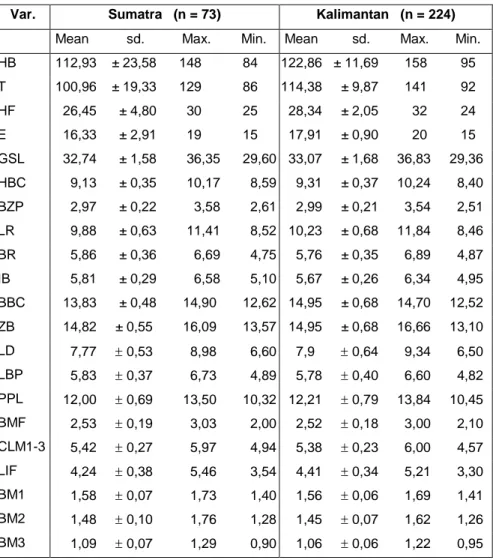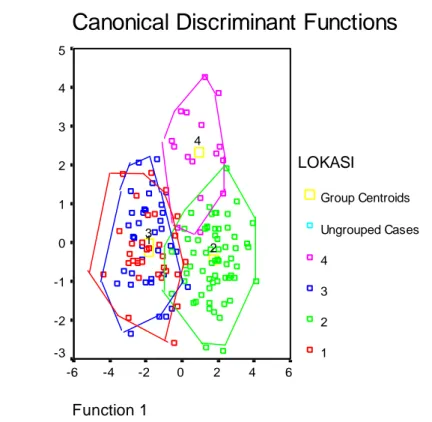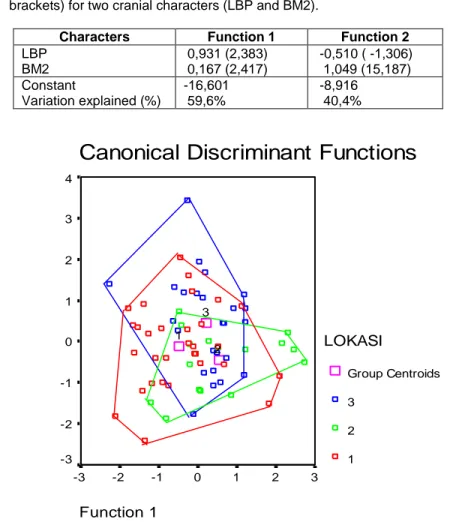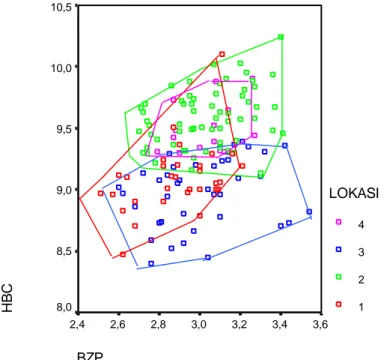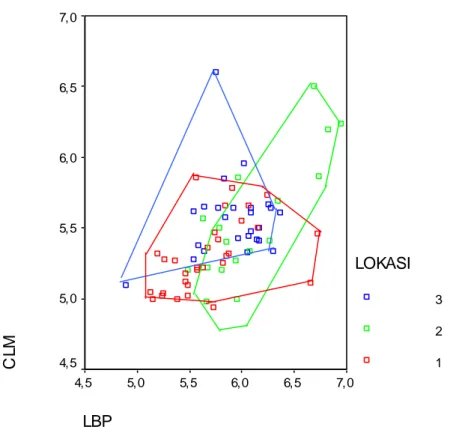V
Voolluummee 1166,, NNoommoorr 22,, NNooppeemmbbeerr 22000077 ISISSSNN 00221155--119911XX
Z
Z
O
O
O
O
I
I
N
N
D
D
O
O
N
N
E
E
S
S
I
I
A
A
Jurnal Fauna Tropika
SURVEYS OF SIAMESE CROCODILE
(
Crocodylus siamensis
)
HABITAT IN THE MAHAKAM RIVER, EAST KALIMANTAN.
Hellen
Kurniati
... 51
PEMANFAATAN SATWA LIAR DALAM RANGKA KONSERVASI
DAN PEMENUHAN GIZI MASYARAKAT.
Gono Semiadi ...
...63
MORPHOLOGICAL VARIATION OF WHITEHEAD’S RAT
Maxomys
whiteheadi
(Thomas, 1894) (RODENTIA: MURIDAE) FROM
KALIMANTAN AND SUMATRA.
Martua H. Sinaga, Antonia J. Gorog
& Alejandro A. Chinen .
...75
KAJIAN ILMIAH IKAN GAR, FAMILI LEPISOSTEIDAE (
Lepisosteus
spp. &
Atractosteus
spp.): SPESIES ANCAMAN BAGI IKAN ASLI
INDONESIA.
Renny Kurnia Hadiaty
...87
THE FEATHER MITES (ACARI; PTEROLICHIDAE) OF PSITTACINE
BIRDS FROM MANUSELA NATIONAL PARK, SERAM ISLAND.
Sri
Hartini & Janita Aziz
...97
Dr. Dede Irving Hartoto (Limnologi)
Anggota Redaksi
Dr. Hagi Yulia Sugeha (Oseanologi) Dr. Rosichon Ubaidillah (Entomologi) Dr. Dewi Malia Prawiradilaga (Ornitologi)
Ir. Ike Rachmatika MSc. (Ikhtiologi)
Sekretaris Redaksi & Produksi Rochmanah S.Kom Mitra Bestari Dr. Charlie Manolis Dr. Kristofer Helgen Dr. Sampurno Kadarsan Drs. Haryono MSi. Alamat Redaksi Zoo Indonesia
Bidang Zoologi, Puslit Biologi LIPI Gd. Widyasatwaloka Jl. Raya Bogor-Jakarta KM. 46 Cibinong 16911 Telp. (021) 8765056 Fax. (021) 8765068 zooindonesia@yahoo.com
Masyarakat Zoologi Indonesia (MZI) adalah suatu organisasi profesi dengan anggota terdiri dari peneliti, pengajar, pemerhati dan simpatisan kehidupan fauna tropika, khususnya fauna Indonesia. Kegiatan utama MZI adalah pemasyarakatan tentang ilmu kehidupan fauna tropika Indonesia, dalam segala aspeknya, baik dalam bentuk publikasi ilmiah, publikasi popular, pendidikan, penelitian, pameran ataupun pemantauan.
Zoo Indonesia adalah sebuah jurnal ilmiah di bidang fauna tropika yang diterbitkan oleh organisasi profesi keilmiahan Masyarakat Zoologi Indonesia (MZI) sejak tahun 1983. Terbit satu tahun satu volume dengan dua nomor (Juni & Nopember). Memuat tulisan hasil penelitian dan tinjauan ilmiah yang berhubungan dengan aspek fauna tropika, khususnya wilayah Indonesia dan Asia. Publikasi ilmiah lain adalah Monograph Zoo Indonesia - Seri Publikasi Ilmiah, terbit tidak menentu.
86
MORPHOLOGICAL VARIATION OF WHITEHEAD’S RAT Maxomys whiteheadi
(Thomas, 1894) (RODENTIA: MURIDAE) FROM KALIMANTAN AND SUMATRA
Martua H. Sinaga1, Antonia J. Gorog2 & Alejandro A. Chinen3
1
Museum Zoologicum Bogoriense-Indonesian Institute of Sciences (LIPI) Cibinong, West Java, Indonesia 16911
e-mail: usinaga@yahoo.com
2
University of Michigan, Museum of Zoology and Department of Ecology and Evolutionary Biology
1109 Geddes Ave., Ann Arbor, MI 48109, USA
3
Graduate School of Environmental Earth Science Hokkaido University, Sapporo, Japan 060-0811
ABSTRACT
Sinaga, M.H., A.J Gorog & A.A Chinen. 2007. Morphological variation of
Whitehead’s rat Maxomys whiteheadi (Thomas, 1894) (Rodentia: Muridae) from
Kalimantan and Sumatra. Zoo Indonesia 62 (2): 75-86. We conducted a study of
morphological variation in Whitehead’s rat (Maxomys whiteheadi) based on specimens available at the Museum Zoologicum Bogoriense. A total of 224 adult specimens from the Indonesian island’s of Sumatra and Kalimantan were examined using measurements of 17 skull and four external characters. Multiple analyses of variance demonstrated that 20 of characters measured varied significantly with location. Only breadth of zygomatic plate did not show a significant effect by location. One character, hind foot length, was significantly affected by sex, and the characters head and body length, breadth of braincase, and breadth of molar 1 showed a significant interaction (p< 0,05) between sex and location. Three distinct morphological groups of M. whiteheadi were recognized within Kalimantan using discriminant function analysis. These were: a West and East Kalimantan group; a Central Kalimantan group; and a North East Kalimantan group. No distinct morphological groups were observed among the Sumatra specimens. The discriminant analysis indicated that most of the variation (79,9%) distinguished the Kalimantan and Sumatra populations from one another.
Keywords: Whitehead’s rat, Maxomys whiteheadi, Sumatra, Kalimantan
ABSTRAK
Sinaga, M.H., A.J Gorog & A.A Chinen. 2007. Variasi morfologi tikus Whitehead
Maxomys whiteheadi (Thomas, 1894) (Rodentia: Muridae) dari Kalimantan dan
Sumatra. Zoo Indonesia 62 (2): 75-86. Penelitian mengenai variasi morfologi tikus
Whitehead (Maxomys whiteheadi) berdasatrkan specimen koleksi yang ada di
Museum Zoologicum Bogoriense telah dilakukan. Sejumlah 224 spesimen dewasa berasal dari Sumatera dan Kalimantan dianalisa berdasarkan pengukuran 17 karakter tengkorak dan empat karakter mrfologi. Hasil multiple analyses of variance menunjukkan bahwa 20 karakter yang diuji berbeda nyata berdasarkan tipe lokasi. Hanya karakter breadth of zygomatic plate yang tidak berbeda. Satu karakter lainnya, kaki belakang, sangat nyata dipengaruhi oleh jenis kelamin dan karakter panjang kepala hingga badan, breadth of braincase, dan lebar molar ke 1 menunjukkan interaksi yang nyata (p< 0.05) antara jenis kelamin dan lokasi. Tiga kelompok berdasarkan karakter morfologi yang sangat nyata dari M. whiteheadi dari wilayah Kalimantan adalah kelompok Kalimantan Barat dan Timur; kelompok Kalimantan
MORPHOLOGICAL VARIATION OF WHITEHEAD’S RAT Maxomys whiteheadi (Thomas, 1894) (RODENTIA: MURIDAE) FROM KALIMANTAN AND SUMATRA: Zoo Indonesia 2007. 16(2): 75-86
76
Tengah; dan kelompok Timur Laut Kalimantan. Tidak dijumpai hal yang serupa untuk wilayah Sumatera. Hasil discriminant analysis menunjukkan bahwa kebanyakan variasi (79.9%) dapat membedakan antara populasi tikus whithead Kalimantan dengan Sumatra.
Kata kunci: tikus Whitehead, Maxomys whiteheadi, Sumatera, Kalimantan.
INTRODUCTION
The genus Maxomys was originally
assigned to the species Maxomys
bartelsii. Subsequently, Maxomys
was subsumed into the genus Rattus
as a subgenus containing several species, including some species now
placed in the genus Niviventer
(Musser & Carleton 1993). Most of the
currently-recognized species of
Maxomys and Niviventer were placed
in Lenothrix, which also was treated as
a subgenus of Rattus (Ellerman &
Morrison-Scott 1966; Laurie & Hill 1954; Musser et al. 1979). Finally,
Musser and Newcomb (1983)
confirmed that Maxomys is not closely
related to Rattus and restored the
genus-level ranking of Maxomys.
Maxomys comprises small to
medium-sized rats of a generalized
appearance. Key characters of the genus include a long and slender hind foot with smooth and naked plantar surfaces, a tail usually shorter or only slightly longer than head and body, a broad and inflated braincase, broad incisive foramina and small bullae (Musser & Carleton 1993).
Maxomys whiteheadi is a small spiny
rat has a sharply bicolored tail that is shorter than head and body. Dark brown dorsally, and the venter gray, ochraceous color on the anterior flanks. The skull has small bulae, broad incisive foramina, and larger teeth. This species is found on Borneo, Sumatra and the Malay Peninsula south of the Isthmus of Kra, but absent from Java (Musser & Carleton 1993),
In Indonesia, six subspecies M.
whiteheadi are recognized (Musser &
Newcomb 1983; van Strien, 1986;
Corbet & Hill 1992). These are: M. w.
whiteheadi (Thomas 1894) on Middle
East Kalimantan; M.w. melanurus
(Shamel 1940) on the east coast of
Kalimantan; M. w. coritzae (Sody
1941) in Riam Kotawaringin
Southwest Kalimantan; M. w.
batamanus (Lyon 1907) in the Riau
Archipelago; M. w. batus (Miller 1911)
in Aceh, North Sumatra; M. w. subitus
(Chasen 1940) on the Natuna Island.
A seventh putative subspecies (M.
whiteheadi subsp. incert) was
recorded by Sody (1941) in South Sumatra.
In this study, we used a suite of
external and skull morphological
characters to (1) test for morphological
differentiation among the seven
named subspecies of M. whiteheadi,
and (2) examine the effect of sex and
location on morphology of M.
whiteheadi.
MATERIALS & METHODS
A total 224 adult specimens of M.
whiteheadi deposited at the Museum
Zoologicum Bogoriense (MZB) were examined. Adult specimens were selected based on the criteria of
having a fused
basioccipital-basissphenoid suture and fully erupted alveolar molars.
86
Table 1. Raw data of external and cranial measurements (mm) for Maxomys
whiteheadi from Sumatra and Kalimantan. Sd = standard deviation; Min =
minimum; Max = maximum.
Var. Sumatra (n = 73) Kalimantan (n = 224)
Mean sd. Max. Min. Mean sd. Max. Min.
HB 112,93 ± 23,58 148 84 122,86 ± 11,69 158 95 T 100,96 ± 19,33 129 86 114,38 ± 9,87 141 92 HF 26,45 ± 4,80 30 25 28,34 ± 2,05 32 24 E 16,33 ± 2,91 19 15 17,91 ± 0,90 20 15 GSL 32,74 ± 1,58 36,35 29,60 33,07 ± 1,68 36,83 29,36 HBC 9,13 ± 0,35 10,17 8,59 9,31 ± 0,37 10,24 8,40 BZP 2,97 ± 0,22 3,58 2,61 2,99 ± 0,21 3,54 2,51 LR 9,88 ± 0,63 11,41 8,52 10,23 ± 0,68 11,84 8,46 BR 5,86 ± 0,36 6,69 4,75 5,76 ± 0,35 6,89 4,87 IB 5,81 ± 0,29 6,58 5,10 5,67 ± 0,26 6,34 4,95 BBC 13,83 ± 0,48 14,90 12,62 14,95 ± 0,68 14,70 12,52 ZB 14,82 ± 0,55 16,09 13,57 14,95 ± 0,68 16,66 13,10 LD 7,77 0,53 8,98 6,60 7,9 0,64 9,34 6,50 LBP 5,83 0,37 6,73 4,89 5,78 0,40 6,60 4,82 PPL 12,00 0,69 13,50 10,32 12,21 0,79 13,84 10,45 BMF 2,53 0,19 3,03 2,00 2,52 0,18 3,00 2,10 CLM1-3 5,42 0,27 5,97 4,94 5,38 0,23 6,00 4,57 LIF 4,24 0,38 5,46 3,54 4,41 0,34 5,21 3,30 BM1 1,58 0,07 1,73 1,40 1,56 0,06 1,69 1,41 BM2 1,48 0,10 1,76 1,28 1,45 0,07 1,62 1,26 BM3 1,09 0,07 1,29 0,90 1,06 0,06 1,22 0,95
The following standard external
measurements (in mm) were recorded from collectors specimen labels: head and body length (HB) by subtracting tail length (T) from total length (TL); hind foot length (HF); and ear length (E). Seventeen cranial measurements (in mm) were used in this study: greatest skull length (GSL); height
brain case (HBC); breadth of
zygomatic plate (BZP); length of rostrum (LR); breadth of rostrum (BR); interorbital breadth (IB); breadth of
brain case (BBC); zygomatic breadth (ZB); length of diastema (LD); length of bony palate (LBP); post palatal
length (PPL); breadth of
mesopterygoid fossa (BMF); crown length of molars 1-3 (CLM1-3); length of incisive foramina (LIF); breadth of molar 1 (BM1); breadth of molar 2 (BM2); and breadth of molar 3 (BM3). All measurements were made by MHS using Vernier calipers and recorded to two decimal places.Variation due to the factors sex and location, and the
MORPHOLOGICAL VARIATION OF WHITEHEAD’S RAT Maxomys whiteheadi (Thomas, 1894) (RODENTIA: MURIDAE) FROM KALIMANTAN AND SUMATRA: Zoo Indonesia 2007. 16(2): 75-86
78 interaction between these factors was examined by Multiple Analysis of Variance (MANOVA).
Morphological differences among
subspecies and species were
examined using discriminant function analysis (DFA). External characters were not used for the DFA because they might be affected by minor
methodological differences among
collectors. Seventeen cranial
characters were entered into the DFA. The analysis was also run on a reduced set of eleven characters that maximized F values (minimizing Wilks’ lambda values). The DFA plot based on the reduced set of characters reflected that obtained from the full set
of seventeen characters.
Consequently, we present only the analysis of the reduced set characters. Computations for all analyses were undertaken with the SPSS statistical package.
RESULTS
Univariate analysis
Descriptive statistics of external and skull characters for each locality are
presented in Table 1. These
demonstrate that M. whiteheadi from
Kalimantan are larger for most
characters than specimens from
Sumatra with the exception of BR, IB, LBP, BMF, CLM 1-3, BM1, BM2 and BM3.
Multiple Analysis of Variance (MANOVA)
The MANOVA was used to test for the main effect of sex and location, and to examine potential interaction between
these factors, on morphological
characters. All characters values presented in the following MANOVA are raw values (Table 2). Location was found to have a significant effect on most characters (0,05≥ p ≥0,01). The exceptions were BZP, and BMF.
Table 2. MANOVA of skull and external body characters of Maxomyswhiteheadi by
location, sex and interaction.
Variables Location Sex interaction
F Sig. F Sig. F Sig.
HB T HF E GSL HBC BZP LR BR IB BBC ZB LD LBP PPL BMF CLM1-3 LIF BM1 BM2 BM3 10,319 0,000 42,312 0,000 72,001 0,000 27,714 0,000 9,058 0,000 21,896 0,000 2,224 0,053 12,426 0,000 4,815 0,000 6,932 0,000 9,190 0,000 12,623 0,000 10,931 0,000 21,932 0,000 6,579 0,000 2,335 0,043 15,310 0,000 4,384 0,001 12,952 0,000 13,836 0,000 12,809 0,000 0,008 0,927 1,603 0,207 7,577 0,006 0,716 0,398 0,259 0,611 0,634 0,427 0,053 0,818 0,031 0,861 0,188 0,665 0,122 0,727 0,797 0,737 0,219 0,640 0,224 0,637 2,067 0,152 0,101 0,751 0,290 0,590 0,327 0,568 0,488 0,485 3,698 0,056 2,233 0,136 0,231 0,631 4,598 0,001 2,053 0,072 2,150 0,061 0,561 0,730 0,454 0,810 1,726 0,130 0,788 0,559 1,563 0,172 0,761 0,579 2,131 0,063 2,959 0,013 1,946 0,088 0,860 0,509 1,799 0,114 1,307 0,262 0,849 0,516 1,859 0,103 0,764 0,576 2,509 0,031 1,027 0,403 1,114 0,354
86
Only HF was significantly affected by sex (0,05≥ p ≥0,01). A significant interaction between sex and location was observed for HB, BBC, and BM1
(p0,05).
Multivariate analysis
1.Kalimantan group
Sody (1941) described a new
subspecies from Riam Kotawaringin
southwest Kalimantan as coritzae
based the paler pelage of these samples than any other material from Borneo and Sumatra, and the pure
light grey belly compared with M. w.
whiteheadi from Middle East
Kalimantan. We observed similar
differences in pelage in our
specimens.
DFA was carried out for a reduced set
of 11 characters to examine
geographic variation among samples
from Kalimantan. This analysis
reflected similar configuration in
discriminant function space to that using the complete character set. The cumulative variation explained by the first three canonical variate functions was 100%, with function 1,2
and 3 explaining 72,7; 16,3 and 11,0% respectively (Table 3) The overall
percentage of cases correctly
classified to their location was 81,3% for West Kalimantan, 93,8% for Central Kalimantan, 89,7% for East Kalimantan, and 81,3% for North East Kalimantan group.
Misclassifications resulted when
specimens from West Kalimantan population were classified in the Central Kalimantan group (3,1%), and in the East Kalimantan group (15,6%).
Some specimens from Central
Kalimantan were misclassified in the East Kalimantan group (3,1%), and in the North East Kalimantan group (3,1%). Several East Kalimantan specimens are classified incorrectly to West Kalimantan (7,7%) and, to Central Kalimantan (2,6%). Finally,
some North East Kalimantan
specimens are incorrectly grouped with West Kalimantan samples (6,3%), and Central Kalimantan samples (12,5%).
This study clearly showed that there
are three distinct groups of M.
whiteheadi within Kalimantan.
Table 3. Standardized and unstandardized (in bracket) canonical variate function
coefficients for Kalimantan Maxomys whiteheadi (Gunung Palung and Tanjung
Puting, West Kalimantan; Sebangau and Barito Ulu, Central Kalimantan; Bukit Bangkirai, East Kalimantan; and Kayan Mentarang, North East Kalimantan).
Character Function 1 Function 2 Function 3
HBC BZP BR IB ZB LD LBP PPL CLM1-3 BM1 BM2 0,802 ( 3,343) -0,293 (-1,489) -0,082 (-0,263) -0,185 (-0,771) 0,121 ( 0,228) 0,385 ( 0,741) 0,327 ( 1,169) -0,295 (-0,427) 0,463 ( 2,775) 0,369 (-6,562) 0,537 ( 8,382) -0,201 (-0,838) -0,120 (-0,610) -0,821 (-2,621) 0,895 ( 3,725) 1,157 ( 2,181) -0,285 (-0,550) -0,161 (-0,577) -0,560 (-0,811) 0,125 ( 0,747) 0,463 ( 8,242) -0,208(-,3,247) -0,227 (-0,945) 0,482 ( 2,450) -0,283 (-0,904) -0,664 (-2,762) 0,141 ( 0,266) -0,435 (-0,837) 0,077 ( 0,274) 0,903 ( 1,307) 0,599 ( 3,589) -0,177 (-3,153) -0,155 (-2,418) Constant Variation explained (%) -48,437 72,7 -23,543 16,3 -3,415 11,0
MORPHOLOGICAL VARIATION OF WHITEHEAD’S RAT Maxomys whiteheadi (Thomas, 1894) (RODENTIA: MURIDAE) FROM KALIMANTAN AND SUMATRA: Zoo Indonesia 2007. 16(2): 75-86
80 These are: a Central Kalimantan
group, described as M. w. whiteheadi
by Thomas (1894); a North East
Kalimantan group (previously
unnamed);, and a West and East
Kalimantan group, described as M. w.
coritzae (Sody 1941) from Riam
Kotawaringin that close with Gunung
Palung location that specimens
examined and we assumed as representative of West Kalimantan,
and M. w. melanurus (Shamel 1940)
from east coast Kalimantan as
representing East kalimantan were clustered together as a group. The plots of function 1 and 2 indicates that specimens from West Kalimantan and
East Kalimantan overlap in 11
selected characters analyzed (Figure 1).
2.Sumatra group
Within Sumatra, three subspecies of
M. whiteheadi were recognized by
Chasen: M. w. batus from Aceh, North
Sumatra; M. w. batamus from the Riau
Archipelago and central East Sumatra; and a group from South Sumatra recognized by Sody (1941) as distinct
subspecies (M. whiteheadi subsp.
incert.).
The DFA for the Sumatra population was run using two selected characters (LBP & BM2). A total of 57,5% of original grouped cases were correctly classified. The DFA also extracted two significant functions that explained
100% of variation. Function 1
explained 59,6% of the variance, and function 2 explained 40,4% (Table 4).
Canonical Discriminant Functions
Function 1
6 4 2 0 -2 -4 -6F
u
n
ct
io
n
2
5 4 3 2 1 0 -1 -2 -3LOKASI
Group Centroids Ungrouped Cases 4 3 2 1 4 3 2 1Figure 1. Plot of function 1 against 2 from canonical variate analysis of M. whiteheadi
Kalimantan group. (1) Gunung Palung and Tanjung Putting (West Kalimantan); (2) Sebangau and Barito Ulu (Central Kalimantan); (3) Bukit Bangkirai (East Kalimantan) and (4) Kayan Mentarang (North East Kalimantan).
86
Table 4. Canonical variate function coefficient in the Sumatra populations of M.
whiteheadi. Standardized values followed by unstandardized values (in
brackets) for two cranial characters (LBP and BM2).
Characters Function 1 Function 2
LBP BM2 0,931 (2,383) 0,167 (2,417) -0,510 ( -1,306) 1,049 (15,187) Constant Variation explained (%) -16,601 59,6% -8,916 40,4%
Canonical Discriminant Functions
Function 1 3 2 1 0 -1 -2 -3
F
u
n
ct
io
n
2
4 3 2 1 0 -1 -2 -3 LOKASI Group Centroids 3 2 1 3 2 1Figure 2. Plot of functions 1 and 2 from canonical variate analysis of Sumatra M.
whiteheadi samples. (1) Aceh, Tapanuli Selatan (North Sumatra); (2) Jambi
(Central Sumatra), and (3) Bengkulu, Lampung, Palembang (South Sumatra).
Table 5. Standardized and unstandardized (in the bracket) canonical variate function
coefficients of M. whiteheadi from Kalimantan and Sumatra.
Characters Discriminant function Group Centroids
HBC LR BR IB BBC LBP BM2 Constant Variation explained (%) -0,807 ( -2,210) -1,003 ( -1,511) 0,402 ( 1,141) 0,463 ( 1,676) 0,388 ( 0,884) 0,533 ( 1,381) 0,313 ( 3,858) -6,239 100 Kalimantan -0,539 Sumatra 1,115
MORPHOLOGICAL VARIATION OF WHITEHEAD’S RAT Maxomys whiteheadi (Thomas, 1894) (RODENTIA: MURIDAE) FROM KALIMANTAN AND SUMATRA: Zoo Indonesia 2007. 16(2): 75-86
82 Subspecies designations by previous taxonomists (Chasen 1940; Sody
1941) indicating that the North
Sumatra form differed from Riau Archipelago and South Sumatra were
not upheld with this study as
demonstrated by a plot of function 1 against 2 (Figure 2). The plot shows that all specimens from North, Central, and South Sumatra are clustered
tightly together, indicating that
samples from different localities in Sumatra were morphologically similar. 3. Kalimantan and Sumatra group We compared the Kalimantan samples with the Sumatra samples using a DFA was run using seven selected characters, these are: HBC, LR, BR, IB, BBC, LBP, and BM2. A total of 79,9% of original grouped cased correctly classified. 18,5% or 28
specimens of Kalimantan were
misclassified into Sumatra population. Some specimens from Sumatra are classified incorrectly to Kalimantan (23,3%, or 17 samples; Table 5).
DISCUSSION
Our examination of 21 morphological characters from 224 specimens of
Indonesian M. whiteheadi
demonstrated a clear morphological division between Kalimantan and Sumatran populations. This result is consistent with those of a previous
phylogenetic analysis of M. whiteheadi
using mitochondrial DNA (Gorog et al. 2004). In this earlier study, rats from
Kalimantan represented a
well-supported lineage distinct from
animals in the Malay Peninsula and Sumatra. This is consistent with the hypothesis that rainforest habitats on Kalimantan have been long isolated from rainforests to the west, even during periods of low sea level when land bridges among islands were formed.
Within the island of Kalimantan, three
distinct morphological groups of M.
whiteheadi were found among the
samples examined (N=151). One is represented by samples from West and East Kalimantan, the second is represented by samples from Central
Kalimantan, and the third by
specimens from Northeast Kalimantan
(Figure 3). Considerable
phylogeographic structure
within-species variation on Kalimantan has been found for many other taxa,
including the red spiny rat Maxomys
surifer (Gorog, Sinaga & Engstrom,
2004), orangutan Pongo pygmaeus
(Warren et al. 2001), and the
white-crowned forktail Enicurus leschenaulti
(Moyle et al. 2005). These patterns are most likely the result of historical isolation caused by the island’s multiple mountain ranges, large rivers, the formation of rain forest refugia
during cooler periods of the
Pleistocene, or previously higher sea levels.
The morphological groups of M.
whiteheadi identified on Kalimantan
differ from the recognized geographic
subspecies in the following way: M. w.
melanurus (Shamel 1940) from East
Kalimantan and M. w. coritzae (Sody
1941) from West Kalimantan are same
subspecies. A new subspecies
recognized in this study is from North East Kalimantan (Kayan Mentarang)
and M. w. whiteheadi (Thomas 1894)
is valid representing Central
Kalimantan.
Our morphological analysis of M.
whiteheadi on Sumatra (N=73)
revealed no distinct morphological groups on this island (Figure 4). Few previous studies of other taxa have used adequate sampling of Sumatran populations to test for geographic differentiation within the island. One, however, similarly demonstrated no genetic structure among populations
of a primate, Macaca nemestrina, on
Sumatra (Rosenblum et al. 1997). These results may be indicative of little
86
historical isolation of Sumatran
populations, or, alternatively, recent expansion from a single rain forest refugium.
This result is not consistent with previous subspecies taxonomy of
Sumatran M. whiteheadi. Miller (1911)
recognized M. w. batus from North
Sumatra; Lyon (1907) named M. w.
batamus from Riau and Central
Sumatra; and Sody (1941) described a population from South Sumatra that he
considered to be unique. However, our
analysis found no morphological
differentiation in populations
throughout the length of Sumatra.
The comparison of patterns of
morphological and genetic
differentiation from multiple taxa
sampled from the same localities throughout Kalimantan and Sumatra would shed greater light of patterns of vicariance and faunal evolution in the region. BZP 3,6 3,4 3,2 3,0 2,8 2,6 2,4 H B C 10,5 10,0 9,5 9,0 8,5 8,0 LOKASI 4 3 2 1
Figure 3. Bivariate plot of HBC and BZP of Maxomys whiteheadi from Kalimantan. (1)
Gunung Palung and Tanjung Putting (West Kalimantan); (2) Sebangau and Barito Ulu (Central Kalimantan); (3) Bukit Bangkirai (East Kalimantan) and (4) Kayan Mentarang (North East Kalimantan).
MORPHOLOGICAL VARIATION OF WHITEHEAD’S RAT Maxomys whiteheadi (Thomas, 1894) (RODENTIA: MURIDAE) FROM KALIMANTAN AND SUMATRA: Zoo Indonesia 2007. 16(2): 75-86 84
LBP
7,0 6,5 6,0 5,5 5,0 4,5C
L
M
7,0 6,5 6,0 5,5 5,0 4,5LOKASI
3 2 1Figure 4. Bivariate plot of CLM and LBP of M. whiteheadi from Sumatra group. 1)
Aceh, Tapanuli Selatan (North Sumatra); (2) Jambi (Central Sumatra), and (3) Bengkulu, Lampung, Palembang (South Sumatra).
ACKNOWLEDGEMENTS
The authors wish to express their gratitude to Achmad Saim B.Sc. for his collection from Sebangau Central Kalimantan that examined, Nanang and Wahyu for prepared many skulls for this study. Thanks are also due to Drs. A. Suyanto, M.Sc. for permission to examine specimens under his care.
REFERENCES
Chasen, F. N. 1940. A handlist of Malaysian Mammals. Bull. Raffles Mus., 15. 209pp. Corbet, G.B. & J.E. Hill. 1992. The
Mammals of the Indo-Malayan region: A Systematic review. Oxford Univ. Press. 488pp.
Ellerman, J. R. & T. C. S. Morrison-Scott. 1966. Checklist of
Palaeartic and Indian
Mammals. British Mus. (Nat. Hist.) London. 810pp.
Gorog, A.J., M.H. Sinaga & M.D. Engstrom. 2004 Vicariance or
Dispersal? Historical
Biogeography of Three Sunda
Shelf Murine Rodents
(Maxomys surifer,Leopoldamys
sabanus and Maxomys
whiteheadi). Biological Journal
of the Linnean Society 81: 91-109.
Kitchener, D. J. & A. Suyanto. 1996.
Intraspecific Morphological
Variation Among Island
Populations of Small Mammals in Southern Indonesia. In: Kitchener & Suyanto (eds)
86
Proceeding of the First
International conference on
Eastern Indonesian-Australian
Vertebrate Fauna, Manado,
Indonesia, November 22-26. Laurie, E. M. O. & J. E. Hill. 1954.
List of Land Mammals of New Guinea, Celebes and Adjacent Islands. British Mus. (Nat. Hist.) London. 175pp.
Moyle, R.G., M. Schilthuizen, M.A. Rachman & F.H. Sheldon. 2005. Molecular Phylogenetic Analysis of the White-Crowned
Forktail Enicurus leschenaulti in
Borneo. Journal of Avian Biology 36: 96-101.
Musser G.G. & M. D. Carleton 1993. Family Muridae. In: Wilson D. E. & D. M. Reeder. Mammals
Species of the World: A
Taxonomic and Geographic
reference. Washington
Smithsonian University Press. 501-755.
Musser, G.G., J.T. Marshall & Boeadi. 1979. Definition and Contents of the Sundaic Genus Maxomys (Rodentia, Muridae). Journal of Mammalogy 60: 592-606. Musser, G.G. & C. Newcomb. 1983.
Malaysian Murids and the Giant Rat of Sumatra. Bulletin of the American Museum of Natural History 174: 329-598.
Myer, E. & P.D. Ashlock. 1991
Principles of Systematic
Zoology. 2nd, edition McGraw
Hill International.
Rosenblum L.L., J. Supriatna & D.J.
Melnick. 1997.
Phylogeographic Analysis of Pigtail Macaque Populations
(Macaca nemestrina) Inferred
from Mitochondria DNA. Amer. Jour. of Phys. Anthrop. 104: 35-45.
Sody, H. J. V. 1941. On a Collection of Rats From the Indo-Malayan
and Indo-Australian Region
(with descriptions of 43 new
genera, species and sub
species). Treubia 18: 255-325. Thomas, O. 1894. A Preliminary
Revision of the Bornean
Species of the Genus Mus. Annals Mag. Nat. Hist. 14: 449-460.
van Strien, N. J. 1986. Abbreviated Checklist of the Mammals of
the Australian Archipelago.
School of Environmental
Conservation Management,
Bogor.
Warren, K. S., E.J. Verschoor, S. Langenhuijzen, Heriyanto, R.A.
Swan, L. Vigilant & J.L.
Heeney. 2001 Speciation and
Intrasubspecific Variation of
Bornean Orangutans, Pongo
pygmaeus pygmaeus.
Mollecular Biology & Evolution 18: 472-480.
MORPHOLOGICAL VARIATION OF WHITEHEAD’S RAT Maxomys whiteheadi (Thomas, 1894) (RODENTIA: MURIDAE) FROM KALIMANTAN AND SUMATRA: Zoo Indonesia 2007. 16(2): 75-86
